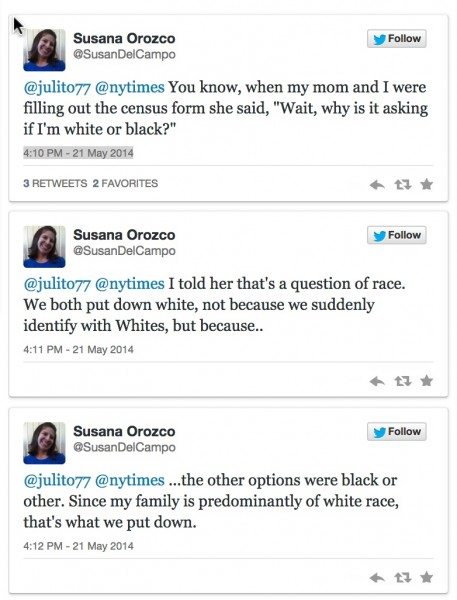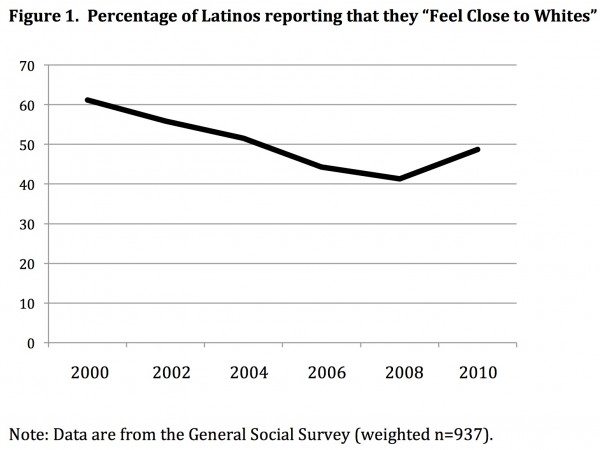Earlier this week, I received an email from Lance Hannon, a Professor of Sociology at Villanova University. Professor Hannon wanted to let me know that he and Robert DeFina, Professor and Chairperson of Villanova’s Department of Sociology and Criminology, had just published a working paper entitled, “Controversy in the Sociological Meaning of Changes in Latino Racial Self-Identification,” in response to the controversy generated by New York Times Upshot writer Nate Cohn that more and more U.S. Latinos were becoming white in this country.
Controversy in the Sociological Meaning of Changes in Latino Racial Self-Identification
The paper cited a few posts from LatinoRebels.com (our group’s work was mentioned in the first paragraph), saying the responses by our contributors “sounded rather technical, like something that one might read in a social science methods textbook.” (I took that as a compliment.) Nonetheless, the Villanova paper utilized some of our key critiques (and those of others) to conclude that writers like Cohn completely missed the mark on this topic.
To cite the paper’s main conclusion (pp. 1–2):
We believe that this critique offers important lessons for a burgeoning body of sociological research on racial fluidity. As did Cohn, sociologists have tended to over-theorize shifts in racial identity and have not given appropriate attention to the more mundane but very real possibility of measurement error. At a more conceptual level, we think that sociologists interested in fluidity need to grapple with the notion that racial identity choices can vary both in the content of one’s stated belief and the degree to which one meaningfully believes it.
In addition to our conceptual critique, we conducted an empirical analysis using data from the highly regarded General Social Survey (GSS). Importantly, the dataset contains information on racial self-identification for Latinos where the questions about race were asked in the same way across time periods to the same individuals. That consistency in question wording over time allows us to make the apples-to-apples comparison that is needed to draw sensible conclusions.
Consistent with the notion that racial identity is less defined for Latinos than other groups, analysis of the GSS data revealed that 39.2% of the Latino sample changed their chosen race at least once within just a 4-year period (compared to only 2.6% of the non-Latino sample). We argue that the fact that so many Latinos changed their answer within such a short timespan implies that it is highly unlikely that the dynamic is driven by personal identity transformations associated with changes in social status. Moreover, at the end of that short timespan about the same proportion of Latinos identified as white as in the beginning, since many individuals were simply vacillating back and forth between “other” and “white.” Additionally, looking directly at an attitudinal question in the GSS, it appears that, if anything, Latinos feel significantly less close to whites than they did a decade ago. All of these results suggest that claims of a new trend of Latino assimilation into whiteness are premature.
“All of these results suggest that claims of a new trend of Latino assimilation into whiteness are premature.”
The paper also summarized a series of tweets I received earlier this year that fully capture the main issue:
Later, the professors write the following: “In our opinion, it is crucially important to distinguish between cases where people switch from one strongly embraced identity to another from instances where the term ‘fluidity’ could easily be replaced with ‘ambivalence.’ (p. 5)” They also include this on pages 7 and 8:
Has there been a significant increase in Latino identification as white?
In 2000, 55.9% of Latinos in the GSS (n=229) listed “white” as their race. In 2010, 53.0% of Latinos in the GSS (n=256) selected “white” as their race. In contrast to results using Census data (where the race question is different in 2000 than in 2010), the GSS (where the race 8question is the same in 2000 and 2010) does not suggest a trend toward whitening among Latinos.Are Latinos feeling closer to whites?
The GSS includes a question that asks respondents to rate their closeness to whites on a nine- point scale with 1 indicating “Not close at all” and 9 indicating “Very close.” This item has been used in dozens of social science studies on trends in racial integration (e.g., Bobo et al. 2009). In 2000, the average score for the closeness-to-white variable among Latinos was 6.64 (n=152). In 2010, the average score was 6.03 (n=151). Alternatively described, 61.2% of Latinos indicated a value on the “close” side of the scale (above 5) in 2000 while only 48.7% of Latinos did so in 2010. Therefore, these results actually imply less assimilation into whiteness among Latinos for the 2000 to 2010 period (see Figure 1).
Just as other academics wrote, the Villanova professors emphasize that Cohn’s initial piece (and his eventual doubling down of his own faulty conclusions) lacked the complex nuances regarding the messiness of U.S. Latino identity. This Villanova working paper is just the latest example of what has become a series of must-read papers to refute Cohn’s reporting and question why Cohn made his conclusions in the first place.
I said it before and I will say it again: when the New York Times lacks the editorial diversity to understand these very real nuances, there is a danger to misreport and misrepresent.
It is encouraging to see more and more academics understand why Cohn’s piece was highly problematic in the first place and why reporters need to be more responsible.
***
EDITOR’S NOTE: Julio (Julito) Ricardo Varela (@julito77) founded LatinoRebels.com in May, 2011 and proceeded to open it up to about 20 like-minded Rebeldes. A 1990 Harvard graduate in the History and Literature of Latin America, his personal blog, juliorvarela.com, has been active since 2008 and is widely read in Puerto Rico and beyond. He pens columns on LR regularly. In the last two years, Julito represented the Rebeldes on CBS’ Face the Nation, NPR, Univision, and The New York Times. Recently, he was a digital producer for Al Jazeera America’s The Stream.






we offer guarantees for privacy protection,
original content, timely delivery, free revisions, and full refund. You
can contact our 24/7 support staff any time you think the term paper you
have received is below par.
http://great-term-paper.com/